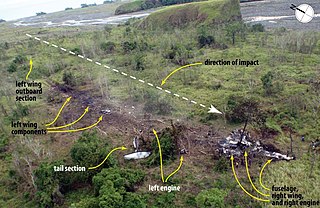Lae (German: Preußen-Reede, later Lehe) is the capital of Morobe Province and is the second-largest city in Papua New Guinea. It is located near the delta of the Markham River and at the start of the Highlands Highway, which is the main land transport corridor between the Highlands Region and the coast. Lae is the largest cargo port of the country and is the industrial hub of Papua New Guinea. The city is known as the Garden City and home of the University of Technology.

Morobe Province is a province on the northern coast of Papua New Guinea. The provincial capital and largest city is Lae. The province covers 33,705 km2, with a population of 674,810, and since the division of Southern Highlands Province in May 2012 it is the most populous province. It includes the Huon Peninsula, the Markham River, and delta, and coastal territories along the Huon Gulf. The province has nine administrative districts. At least 101 languages are spoken, including Kâte and Yabem language. English and Tok Pisin are common languages in the urban areas, and in some areas pidgin forms of German are mixed with the native language.

Officially named Nadzab Tomodachi International Airport, Nadzab Airport is a regional airport located at Nadzab 42 kilometres (26 mi) outside Lae, Morobe Province, Papua New Guinea along the Highlands Highway. It is served by both private and regional aircraft with domestic flights. The airport replaced the Lae Airfield in 1977.

Malahang is a suburb of Lae, Morobe Province in Papua New Guinea.
Nadzab Village is in the Markham Valley, Morobe Province, Papua New Guinea on the Highlands Highway. Administratively, it is located in Gabsongkeg ward of Wampar Rural LLG. The Nadzab Airport is located East of Nadzab Village and was the site of the only Allied paratrooper assault in New Guinea on 5 September 1943.

On 13 October 2011, Airlines PNG Flight 1600, a Dash 8 regional aircraft on a domestic flight from Lae to Madang, Papua New Guinea, crash-landed in a forested area near the mouth of the Guabe River, after losing all engine power. Only four of the 32 people on board survived. It was the deadliest plane crash in the history of Papua New Guinea.

Butibam is a village on the outskirts of Lae, Morobe Province in Papua New Guinea.
Taraka is a suburb of Lae in the Morobe Province, Papua New Guinea. The main campus for the Papua New Guinea University of Technology is located in Taraka.
Tent City (Tent siti) is a suburb of Lae in the Morobe Province, Papua New Guinea. The main campus for the Papua New Guinea University of Technology is located 1 kilometre to the South of Tent City.
Bumayong is an outer suburb of Lae in the Morobe Province, Papua New Guinea.

Situm is a government ex-servicemen block outside of Lae in Labuta Rural LLG, Morobe Province, Papua New Guinea.
Dowsett is a suburb of Lae in the Morobe Province, Papua New Guinea.
Bumneng is a suburb of Lae in the Morobe Province, Papua New Guinea.
Eriku is a suburb of Lae in the Morobe Province, Papua New Guinea.
The Lae Botanic Gardens are located in Bumneng, Eriku and Lae City in the Morobe Province, Papua New Guinea. Within this location is the Papua New Guinea Forest Research Unit, the Papua New Guinea National Herbarium and the Lae War Cemetery.

Yalu is a large village in Wampar Rural LLG, located in the Markham Valley of Morobe Province, Papua New Guinea. It lies along the Highlands Highway 21.5 kilometres (13.4 mi) north-west of Lae, 7 kilometres (4.3 mi) southeast of Nadzab. The landscape is typically lowland rainforest.

3 Mile is a suburb of Lae in the Morobe Province, Papua New Guinea.
6 Mile is a suburb of Lae in the Morobe Province, Papua New Guinea.
9 Mile is a large village in the Markham Valley of Morobe Province, Papua New Guinea. It lies along the Highlands Highway 9 miles (14 km) from the center of Lae between the foothills of the Atzera Range and the Markham River. The Atzera Range starts at Bugandi and runs adjacent to the Markham River has an elevation of 280 meters above sea level. northwest of Lae, 7 kilometres (4.3 mi) southeast of Nadzab. The landscape is typically lowland rainforest.

As the township of Lae, in Morobe Province, Papua New Guinea is a relatively new entity, the history of the Lae environs is much older.














